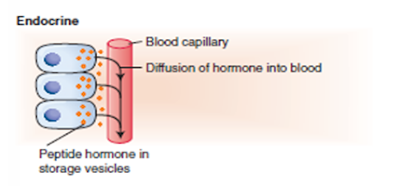Intercellular communication systems
Intercellular communication systems
The
maintenance of homeostasis requires the coordination of cells, tissues, and
organs. Most communication between cells is achieved by the release of chemical
messengers.
The modes of intercellular communication are described as follows:
Neural communication.
Endocrine communication.
Neuroendocrine control.
Paracrine communication.
Autocrine signaling.




5. Autocrine signaling.
Endocrine communication.
Neuroendocrine control.
Paracrine communication.
Autocrine signaling.
1. Neural communication.

Neural communication
occurs by rapid information transfer using electrical signals; the release of
neurotransmitters at synapses between neurons or at a target cell such as a
muscle produces a response (e.g.
acetylcholine ).
2. Endocrine communication.

Endocrine communication occurs by the release of a chemical
transmitter (hormone) by specialized endocrine cells and is carried to a
distant site of action via the blood (e.g. insulin).
3. Neuroendocrine control.

Neuroendocrine control is a hybrid of neural and endocrine communication in which neurons (not endocrine cells!) release a chemical transmitter (neurohormone) that is carried to a distant site of action via the blood; (e.g. antidiuretic hormone ).

Paracrine communication involves cells that secrete chemical transmitters locally into the surrounding interstitial fluid; the target cells are near “neighbors” and are reached by diffusion of the hormone through intracellular fluid (e.g. hormones of gut mucosa) .
5. Autocrine signaling.

Autocrine signaling occurs when a cell regulates itself by the release of a chemical messenger (e.g. prostaglandin).
